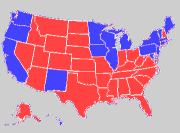
Grandfather Economic
Report series
| Home & Contents
| Summary | Feedback | What's New | Link Index | Must See | Email
PRESIDENTIAL ELECTION 2000 |

the 2000 Presidential election
appeared like America is two nations, not one,
as major population centers overwhelm the diversity of the rest of the nation.
(after you read this report you may also wish to review The 2004 Presidential Election Report)
The Grandfather Economic Reports is a series of picture reports of threats to the economic future of families and their children, compared to prior generations. You are now at the brief chapter on Trends in Public Voting in the 2000 Presidential national election. Welcome. We hope your visit will find useful information to help you and your loved ones. (see report at https://grandfather-economic-report.com// ).
Presidential Election Results by State and by County
November 7, 2000
volume voting in large population centers nearly overwhelmed the rest of the nation
4 pictures tell a very powerful story
 ELECTION RESULT BY STATE
ELECTION RESULT BY STATE
George W. Bush won the 2000 presidential election, with 271 electoral votes of the required 270. This map shows the vote by state.
Texas Governor George W. Bush won the popular vote in the 30 states marked in red.
Vice President Al Gore won the popular vote in the states marked in blue.
Although Bush won the popular vote in 60% of the 50 states, and therefore barely enough electoral votes to win the election,
Gore, winning the popular vote in 40% of the states, won 543,895 more nation-wide popular votes than did Bush.
This was one of the closest elections in history.
It is informative to examine this outcome in a bit more detail.
This map of the United States, showing the 2000 Presidential election results by county, is most dramatic.
It reveals a dramatic picture of how voting by major population centers overwhelms the impact of citizens living in counties without large cities.
Vice President Gore won the blue counties - - Governor Bush won the red counties.
Although Gore won the nation-wide popular vote by 0.3%, by winning 71% of the vote in mega-population centers, this map shows >
<You can click the above map to enlarge it for a dramatic view, then click your back button to return to this spot.>
(The map above, of voting nationwide-by-county map, from USA Today - - also published at http://www.mises.org/jefffiles/usmap.gif)
This 80-20% split nationally by county also showed up at the state
level.
Take Florida and New York as examples:
Presidential Election in Florida - December 2000
In the very close popular vote in Florida,
that narrowly determined Governor George Bush's victory and won for him the Presidency - -
George Bush won 51 (77%) of Florida's 67 counties - colored gray,
and Gore won 16 (23%) of the counties (primarily the population centers) - colored blue.
This 80-20% result was similar to the above nation-wide by-county data.
<You can click the above Florida map to enlarge it, then click your back button to
return to this spot.>
Florida chart from The Longboat Observer, 28 December 2000, pg. 8A
An additional correlation to the 80-20% county vote nation-wide and in Florida occurred in New York,
According to data from the N.Y. Board of Elections for the 2000 New York senatorial race-
the loser, Rick Lazio, won 47 (76%) of the 62 counties in the state, whereas the winner,
Hillary Clinton, won just 15 (24%) of the 62 counties, but she won the big city population areas, giving her the state-wide popular vote and the election.
This near 80-20% by-county result in New York was similar to the above nation-wide by-county data ratio, as well as the Florida by-county ratio.
<You can click the New York map to enlarge for a more dramatic view, then click your
back button to return to this point.>
(published at http://www.FreeRepublic.com/forum/a3a3fa0ef655f.htm )
This is a very interesting picture of current election patterns in America. Large city populations vs. the rest of the nation - - almost appearing as if America is approximately equally divided between large population center voting volumes representing 20% of the nation's counties, and the rest of the nation representing 80% of the counties.
The Constitution's mandate (Article II, Sect. 1) for the electoral college to decide presidential elections appears to be weakening in its attempt to do what the founding forefathers intended - - which was, in deciding elections, to demand the electoral college system within each state somewhat protect and better project power and influence of individual states AND to represent the diversity of smaller states and their citizen votes in relation to citizen votes in large population centers. Regarding the races in individual states for President and for its senators, perhaps some type of electoral college system should be adopted in each state to also better protect individual counties and their diversity - otherwise we may continue to see a diminishing influence of smaller states and counties nation-wide - - looking forward.
Additionally it should be pointed out that the original Constitution called for U.S. senators to be appointed by state legislatures (not by popular vote), in order to provide state power over the federal government and to reflect that the Constitution was intended to form a republic, not a democracy by simple majority. Only members of the House of Representatives were to be elected by popular vote. But, a later amendment provided for senators to be elected by popular vote which reduced state legislative influence. Perhaps the nation's original founding forefathers had it right > > senators elected by state legislatures, not by majority citizen vote.
Data by urban vs. rural
Al Gore won 71% to Bush's 26% of the vote in mega - city population centers over 500,000 in size and therefore the popular vote nation-wide by a narrow 0.3% margin. Bush won 60% to Gore's 38% of the vote in smaller population centers (10,000 to 50,000 in size) and 60% in rural areas. (see population center vote chart)
Religious vote
George Bush won up to 65% of the vote of those who attend religious services weekly or more. Gore won 61% of those who never attend such services. (see religious vote chart).
Vote margin of victory - - Bush vs. Gore
Although Bush won the electoral count (with 271) and the election, Gore won the popular vote by 543,895. Final popular vote count for Gore was 50,999,897 (48.38% of 105,405,100 total votes cast for all candidates) vs. Bush's popular vote count of 50,546,002 (47.87%). Mr. Nadar won 2.9 million (2.74%) popular votes.
An interactive map demonstrating margin of victory (click its tab for 2000) for those interested in a bit more detail. Note: in that graph Gore is blue and Bush is red, and the picture is a bit slow to load.
The 2004 Election - - Bush vs. Kerry
After reviewing the above for the 2000 election you may wish to review the following >
The 2004 Presidential Election Report - dramatic graphics show the results of the 2004 presidential election - - a much more decisive result.
Voter Turn-Out
See the Voter Turn-Out Report to view revealing graphics of the continual decline of nation-wide turn-out for past presidential and congressional elections.
Return to the index of the Grandfather
Economic Reports at https://grandfather-economic-report.com/
Email Michael Hodges
| Home & Contents | Summary | 12 Questions | Feedback | What's New | Link Index | Eye-opener | Must See |
Copyright © 2000-2010 Michael W. Hodges. The Grandfather Economic Report series is the intellectual property of its author; all rights reserved under Copyright Conventions. Permission to redistribute all or part of this series for non commercial purposes is granted by the author, provided the associated web page address is included and full credit given to the Grandfather Economic Report and the author, Michael Hodges. Notice appreciated via email.